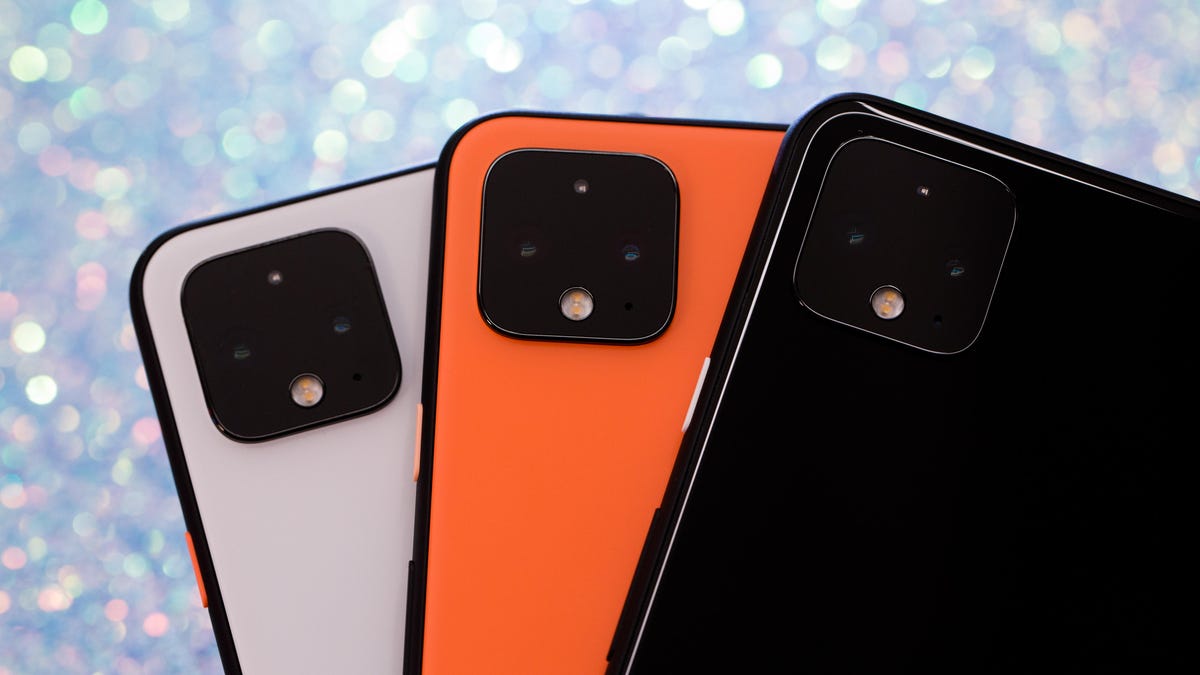Pixel 4 and 4 XL specs vs. iPhone 11, Galaxy S10E and OnePlus 7T
We pit Google's new Pixel phones against their top Android and Apple competitors.

The Pixel 4 and Pixel 4 XL smartphones are looking at you.
Google on Tuesday unveiled its latest smartphones , the Pixel 4 and Pixel 4 XL, at its Made by Google event in New York. The phones feature face unlock and motion sensors (here's how the Pixel 4's face unlock compared to the iPhone 11's Face ID when we tested both in four typical scenarios), a 90Hz OLED display and two back cameras. The Pixel 4 starts at $799, and the Pixel 4 XL starts at $899. (Read our in-depth Pixel 4 review and Pixel 4 XL review here.)
With the Pixel 4 and 4 XL, Google is trying to take full advantage of Android 10 and the fact that Android is the most popular OS in the world. However, Google's Pixel phones face competition from market leaders Samsung , Huawei , and Apple and others on the list of most popular smartphones, according to IDC. The iPhone 11's camera features and Galaxy S10E's battery life in particular could deter people from going with the Pixel.
Still, CNET named the Pixel 3 the best Android phone of 2018, thanks to its impressive cameras and AI-powered call screening feature. The Pixel 4's improved camera features will likely make it a strong smartphone option.
To see how the Pixel 4 and Pixel 4 XL match up against competitors from Apple, Samsung and OnePlus , we compared the two against the iPhone 11 , the Galaxy S10E and the OnePlus 7T, spec by spec.
Take a deeper dive into Pixel 4 comparisons: Here's how the Pixel 4 differs from last year's Pixel 3, and how it stacks up to the Galaxy Note 10.
Based on how they look on paper, what do you think? Are the Pixel 4's new features enough to boost Google's smartphone sales?
Google Pixel 4 and Pixel 4 XL vs. iPhone 11, Galaxy S10E and OnePlus 7T
| Pixel 4 | Pixel 4 XL | iPhone 11 | Galaxy S10E | OnePlus 7T | |
| Display size, resolution | 5.7-inch FHD+ 90Hz OLED | 6.3-inch QHD+ 90Hz OLED | 6.1-inch LCD Liquid Retina; 1,792 x 828 pixels | 5.8-inch AMOLED; 2,280 x 1,080 pixels | 6.55-inch 90Hz AMOLED; 2,400 x 1,080 |
| Pixel density | 444 ppi | 537 ppi | 326ppi | 438ppi | 402ppi |
| Dimensions (Inches) | 2.7 x 5.7 x 0.3 in | 2.9 x 6.3 x 0.3 in | 5.94 x 2.98 x 0.33 in | 5.59 x 2.75 x 0.27 in | 6.33 x 2.93 x 0.32 in |
| Dimensions (Millimeters) | 68.8 x 147.1 x 8.2 mm | 75.1 x 160.4 x 8.2 mm | 150.9 x 75.7 x 8.3 mm | 142 x 69.9 x 7.9 mm | 160.9 x 74.4 x 8.1 mm |
| Weight (Ounces, Grams) | 5.71 oz; 162g | 6.81 oz; 193g | 6.84 oz; 194g | 5.29 oz; 150g | 6.70 oz; 190g |
| Mobile software | Android 10 | Android 10 | iOS 13 | Android 9.0 with Samsung One UI | Android 10.0; OxygenOS 10.0.3 |
| Camera | 16-megapixel (telephoto), 12.2-megapixel (wide) | 16-megapixel (telephoto), 12.2-megapixel (wide) | 12-megapixel (wide), 12-megapixel (ultra-wide) | 16-megapixel (ultra-wide), 12-megapixel (rear) | 48-megapixel (wide), 16-megapixel (ultra-wide), 12-megapixel (telephoto) |
| Front-facing camera | 8-megapixel with Motion Sense face unlock | 8-megapixel with Motion Sense face unlock | 12-megapixel with Face ID | 10-megapixel | 16-megapixel |
| Video capture | 4K | 4K | 4K | 4K | 4K |
| Processor | Qualcomm Snapdragon 855 | Qualcomm Snapdragon 855 | Apple A13 Bionic | Qualcomm Snapdragon 855 | Qualcomm Snapdragon 855 Plus |
| Storage | 64GB, 128GB | 64GB, 128GB | 64GB, 128GB, 256GB | 128GB, 256GB | 128GB, 256GB |
| RAM | 6GB | 6GB | Not disclosed | 6GB, 8GB | 8GB |
| Expandable storage | None | None | None | Up to 512GB | None |
| Battery | 2,800 mAh | 3,700 mAh | Not disclosed, but Apple claims it will last 1 hour longer than iPhone XR | 3,100 mAh | 3,800 mAh |
| Fingerprint sensor | None (Face unlock) | None (Face unlock) | None (Face ID) | Power button | In-display fingerprint sensor |
| Connector | USB-C | USB-C | Lightning | USB-C | USB-C |
| Headphone jack | No | No | No | Yes | No |
| Special features | Water resistant (IP68); Qi-certified wireless charging; 18 W fast charging | Water resistant (IP68); Qi-certified wireless charging; 18 W fast charging | Water resistant (IP68); dual-SIM capabilities (nano-SIM and e-SIM); wireless charging | Wireless PowerShare; hole-punch screen notch; water resistant (IP68); Fast Wireless Charging 2.0 | Warp Charge 30T feature; 90 Hz display; 48-megapixel ultra wide triple camera |
| Price off-contract (USD) | $799 (64GB), $899 (128GB) | $899 (64GB), $999 (128GB) | $699 (64GB), $749 (128GB), $849 (256GB) | $750 | $599 for 8GB RAM/128GB |
| Price (GBP) | £669 (64GB), £769 (128GB) | £829 (64GB), £929 (128GB) | £729 (64GB), £779 (128GB), £879 (256GB) | £669 | £549 for 8GB RAM/128GB |
| Price (AUD) | AU$1,049 (64GB), AU$1,199 (128GB) | AU$1,279 (64GB), AU$1,429 (128GB) | AU$1,199 (64GB), AU$1,279 (128GB), AU$1,449 (256GB) | AU$1,199 | Won't be sold in Australia |
Originally published Oct. 15, 9:15 a.m. PT.
Update, 11:10 a.m.: Includes additional pricing information for the Pixel 4 and Pixel 4 XL.

